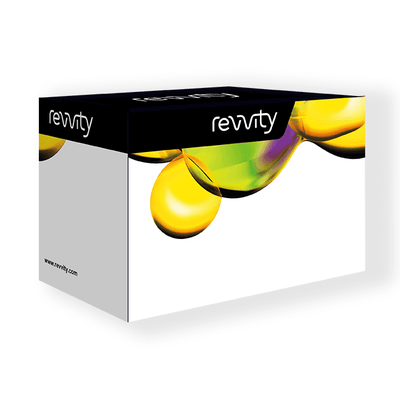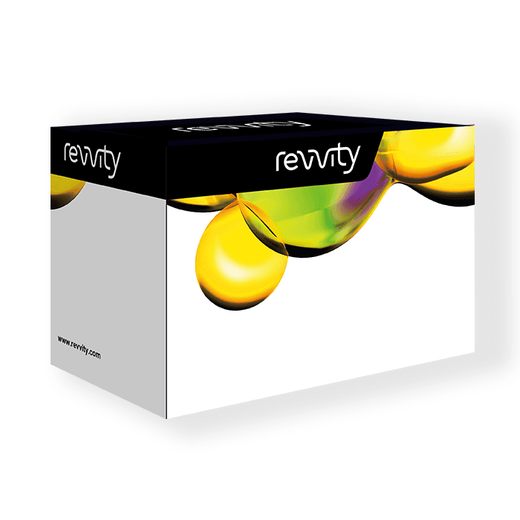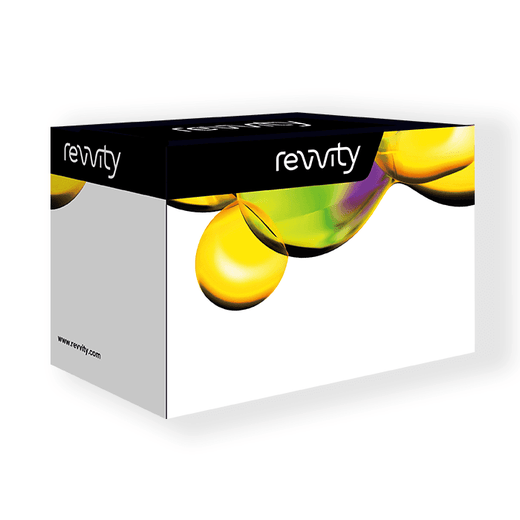

HTRF Human Phospho-JAK2 (Tyr1007/1008) Detection Kit, 500 Assay Points


HTRF Human Phospho-JAK2 (Tyr1007/1008) Detection Kit, 500 Assay Points






This HTRF kit enables the cell-based quantitative detection of phosphorylated JAK2 at Tyr1007/1008 as a readout of cytokine receptor activation.
For research use only. Not for use in diagnostic procedures. All products to be used in accordance with applicable laws and regulations including without limitation, consumption and disposal requirements under European REACH regulations (EC 1907/2006).
| Feature | Specification |
|---|---|
| Application | Cell Signaling |
| Sample Volume | 16 µL |
This HTRF kit enables the cell-based quantitative detection of phosphorylated JAK2 at Tyr1007/1008 as a readout of cytokine receptor activation.
For research use only. Not for use in diagnostic procedures. All products to be used in accordance with applicable laws and regulations including without limitation, consumption and disposal requirements under European REACH regulations (EC 1907/2006).



HTRF Human Phospho-JAK2 (Tyr1007/1008) Detection Kit, 500 Assay Points



HTRF Human Phospho-JAK2 (Tyr1007/1008) Detection Kit, 500 Assay Points



Product information
Overview
JAK2 (Janus kinase 2) belongs to the family of non-receptor Janus tyrosine kinases with JAK1, JAK3, and TYK2. A wide array of cytokines and growth factors ( IL6, IL4, IFN alpha, GM-CSF) attached to their receptors induce the phosphorylation of JAKs. The activated JAKs subsequently phosphorylate additional targets, including both the cytokine receptors and the major substrates: STATs. The JAKs/SATs signaling stimulates cell proliferation, differentiation, migration, and apoptosis. Altering JAK/Stat signaling to reduce cytokine induced pro-inflammatory responses represents an attractive target for anti-inflammatory therapies.
Specifications
| Application |
Cell Signaling
|
|---|---|
| Automation Compatible |
Yes
|
| Brand |
HTRF
|
| Detection Modality |
HTRF
|
| Lysis Buffer Compatibility |
Lysis Buffer 1
Lysis Buffer 4
|
| Molecular Modification |
Phosphorylation
|
| Product Group |
Kit
|
| Sample Volume |
16 µL
|
| Shipping Conditions |
Shipped in Dry Ice
|
| Target Class |
Phosphoproteins
|
| Target Species |
Human
|
| Technology |
TR-FRET
|
| Therapeutic Area |
Inflammation
|
| Unit Size |
500 Assay Points
|
Video gallery

HTRF Human Phospho-JAK2 (Tyr1007/1008) Detection Kit, 500 Assay Points

HTRF Human Phospho-JAK2 (Tyr1007/1008) Detection Kit, 500 Assay Points

How it works
Phospho-JAK2 (Tyr1007/1008) assay principle
The Phospho-JAK2 (Tyr1007/1008) assay measures JAK2 when phosphorylated at Tyr1007/1008. Unlike Western Blot, the assay is entirely plate-based and does not require gels, electrophoresis, or transfer. The Phospho-JAK2 (Tyr1007/1008) assay uses 2 labeled antibodies: one with a donor fluorophore, the other with an acceptor. The first antibody was selected for its specific binding to the phosphorylated motif on the protein, the second for its ability to recognize the protein independent of its phosphorylation state. Protein phosphorylation enables an immune-complex formation involving both labeled antibodies and which brings the donor fluorophore into close proximity to the acceptor, thereby generating a FRET signal. Its intensity is directly proportional to the concentration of phosphorylated protein present in the sample, and provides a means of assessing the protein’s phosphorylation state under a no-wash assay format.

Phospho-JAK2 (Tyr1007/1008) 2-plate assay protocol
The 2 plate protocol involves culturing cells in a 96-well plate before lysis, then transferring lysates into a 384-well low volume detection plate before the addition of Phospho-JAK2(Tyr1007/1008) HTRF detection reagents. This protocol enables the cells' viability and confluence to be monitored.

Phospho-JAK2 (Tyr1007/1008) 1-plate assay protocol
Detection of Phosphorylated JAK2 (Tyr1007/1008) with HTRF reagents can be performed in a single plate used for culturing, stimulation, and lysis. No washing steps are required. This HTS designed protocol enables miniaturization while maintaining robust HTRF quality.

Assay validation
Inhibition measured with Phospho-JAK2 (Tyr1007/1008) & Total-JAK2 kits on HEL92.1.7 cell
HEL92.1.7 cells (Human erythroleukaemia) were seeded in a half area 96-well culture-treated plate at 200,000 cells / well in 20 µL complete culture medium. Cells were treated with 5 µL of increasing concentrations of Ruxolitinib (type I JAK inhibitor) or CHZ868 (Type II JAK inhibitor) for 1h at 37 ° C, 5% CO2 followed by a stimulation step with 5 µL of pervanadate 100 µM during 30 minutes . After treatment, cells were lysed with 10 µl of supplemented lysis buffer # 1 (4X) for 30 min at RT under gentle shaking.
After cell lysis, 16 µL of lysate were transferred into a 384-well sv white microplate, and 4 µL of the HTRF phospho-JAK2 (Tyr1007/1008) or Total JAK2 detection reagents were added. The HTRF signal was recorded after 3 hours at room temperature.
As expected, Ruxolitinib or CHZ868 inhibitors induced a dose-dependent decrease in JAK2 phosphorylation, without effect on the expression level of the total protein.


Inhibition of JAK2 phosphorylation (Tyr1007/1008) on THP1 cells
THP1 cells (Human monocytic leukemia ) were seeded in a half area 96-well culture-treated plate at 400,000 cells / well in 20 µL complete culture medium. Cells were treated with 5 µL of increasing concentrations of Ruxolitinib, Tofacitinib or Pacritinib for 1h at 37 ° C, 5% CO2 followed by a stimulation step with 5 µL of pervanadate at 100 µM during 30 minutes . After treatment, cells were lysed with 10 µl of supplemented lysis buffer # 1 (4X) for 30 min at RT under gentle shaking.
After cell lysis, 16 µL of lysate were transferred into a 384-well sv white microplate, and 4 µL of the HTRF phospho-JAK2 (Tyr1007/1008) or Total JAK2 detection reagents were added. The HTRF signal was recorded after 3 hours at room temperature.
As expected, the results obtained show a dose-response inhibition of JAK2 Y1007/1008 phosphorylation upon treatment with Ruxolitinib, Tofacitinib or Pacritinib, while the JAK2 expression level remains constant.



Phospho -JAK2 (Tyr1007/1008) down-regulation by siRNA
HEL92.1.7 cells were treated with 2.5 µM of Accell siRNA (Horizon) targeting specifically JAK1, JAK2, JAK3 or with a non-targeting siRNA (included as control), in a 96-well plate (200,000 cells/well) under 100 µL. After 48h incubation at 37°C, 50 µL of complete culture medium was added and the cells were incubated for an additional 24h-incubation at 37°C. Cells were stimulated with Pervanadate (100 µM) during 30 minutes and after plate centrifugation, were lysed with 50 µL of supplemented lysis buffer #1 (1X) and 16 µL of lysates were transferred into a low volume white microplate before the addition of 4 µL of premixed HTRF phospho-JAK2(Tyr1007/1008) detection antibodies. The HTRF signal was recorded after an overnight incubation at RT.
Cell treatment with JAK2 siRNA led to a significant downregulation of phospho JAK2 (Tyr1007/1008) with 55% signal decrease compared to the cells transfected with the non-targeting siRNA. No decrease of signal was observed with cells treated with JAK1 or JAK3 siRNA , demonstrating the specificity of the kit

HTRF Phospho-JAK2 (Tyr1007/1008) assay compared to Western Blot
HEL92.1.7 cells were cultured in a T175 flask in complete culture medium at 37°C, 5% CO2. After 72h incubation, the cells were first stimulated with pervanadate 100 µM for 30 minutes, then lysed with 3 mL of supplemented lysis buffer #1 (1X) for 30 minutes at RT under gentle shaking.
Serial dilutions of the cell lysate were performed using supplemented lysis buffer, and 16 µL of each dilution were transferred into a low volume white microplate before the addition of 4 µL of HTRF Phospho-JAK2 (Tyr1007/1008) detection reagents. Equal amounts of lysates were used for a side by side comparison between HTRF and Western Blot.
A side by side comparison of Western Blot and HTRF demonstrates that the HTRF assay is 8-fold more sensitive than the Western Blot, at least under these experimental conditions.

Simplified pathway
Simplified JAK2 signaling pathway
JAK2 in combination with JAK1, JAK3, or Tyk2 interacts with different types of cytokine/interferon receptors (IL2 ,IL4, IL6 , IFN alpha and gamma). Upon cytokine activation, JAK2 and the other members of the JAK family transphosphorylate each other, and then activate the transcription factors STAT1, STAT2, STAT3, STAT5, and STAT6. In turn they dimerize and translocate to the nucleus to trigger the transcription of genes regulating cell differentiation, proliferation, survival, and adapted immune response.

Resources
Are you looking for resources, click on the resource type to explore further.
Discover the versatility and precision of Homogeneous Time-Resolved Fluorescence (HTRF) technology. Our HTRF portfolio offers a...
This guide provides you an overview of HTRF applications in several therapeutic areas.


How can we help you?
We are here to answer your questions.






























